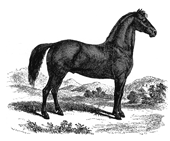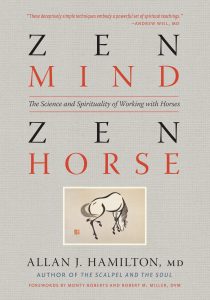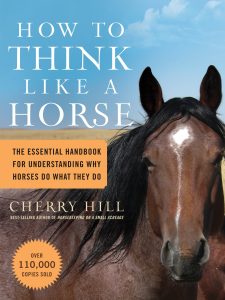
Breed Facts
Status:
Critical
Use:
Riding, Driving
Adult Weight:
400-600 lbs.
Adult Height:
Average 11.2 hands / Max. 12.2 hands
Temperament:
Docile, Alert
Experience Level:
Novice
Notes:
Diminutive horses; proportioned like a horse, not pony; good with children and people; curious
CASPIAN
Small, refined horses appear in Persian art and artifacts from as early as 3,000 BCE. Among these artifacts are the tri-lingual seal of King Darius the Great that shows the King riding a horse so small that his feet almost touch the ground; the staircase frieze at the Palace of Persopolis, that shows numerous small horses pulling chariots; and the chariot pulled by small horses from the Gold Oxus Treasure of Darabgird.
Until recently, it was believed that such horses were long extinct, but the rediscovery of the Caspian strongly suggests that the breed is a direct descendant of these ancient Persian horses. The Caspian horse breed is being studied by the scientific community and The Livestock Conservancy to document its antiquity, characterize its relationship with other breeds, and describe its place in equine history. There is also mounting physical and historical evidence that Caspians may be one of the genetic foundations for several modern horse breeds.
The Caspian horse owes its survival to Iranian aristocrat Narcy Firouz and his American-born wife, Louise Laylin Firouz. Narcy and Louise went to live in Iran in 1957 and taught horsemanship in Tehran. One of the difficulties they faced was finding small, even-tempered mounts for the children they instructed. This led them to explore rumors of small horses that lived in the remote villages of the Elburz region above the Caspian Sea.
In 1965, they went on an expedition to this region and found that the rumors were true: there were, indeed, a few distinctive and diminutive horses. Louise named the breed the “Caspian” and the couple, taken by these unique horses, established a breeding center for their conservation. As the number of Caspians in their herd increased, they selected a few for export and sent 26 horses to Europe between 1971 and 1976. These became the foundation for the breed’s survival outside of Iran. In 1994 the first Caspians that would be part of a breeding program arrived in the United States from England.
The massive political upheavals in Iran have created significant obstacles to the Caspian’s survival in its native country. Despite these setbacks, the Firouzes continued to live in Iran and work diligently on behalf of the Caspians and other rare breeds such as the Turkmen horse, which can still be found in the region. Sadly, Narcy passed away in 1994, leaving Louise to continue working with her beloved horses until her passing in 2008. Shortly after her death, a service was held in Iran honoring Louise as a Turkmen elder. This is the first time in history such an honor was given to a woman. The Turkmen elders attending rode their Turkmen horse to the service.
Small numbers of feral Caspians remain in remote areas near the Elburz mountains of northern Iran. Persicus Farm, a national Caspian stud farm in Iran, was established by Louise Firouz and is still maintained by the Iranian government. The Caspian is considered a national treasure and its future is looking brighter in its home country. Caspian numbers are growing, with the majority of the population outside of Iran concentrated in England. An International Caspian Society (ICS) has been formed to maintain a registry for the breed and support it globally. Under the ICS, regional Caspian societies have been established in Iran, the United Kingdom, Australia, Western Australia, New Zealand, the US, Norway, and Sweden to promote the breed within those countries.
The Caspian has a very distinctive appearance. While small in size, it is proportioned like a horse rather than a pony and, per the standard, “The overall impression should be that of an elegant, small horse.” The breed’s features include a vaulted forehead (different from other breeds), slim body and legs, high croup, and dense coat. Horses average 11.2 hands and should not exceed 12.2 hands at the withers. They reach their adult height by 18 months of age. Caspians are found in all colors except piebald or skewbald (pinto). Grey individuals will transition through many shades of roan before fading to near white at maturity. These highly alert and intelligent horses are excellent as children’s mounts and for beginners, and they excel as event horses with their elegance and outstanding jumping abilities. They also perform well as driving horses.
The breed is loyal, affectionate, alert, and loves the company of humans, with whom they can form close bonds. They are curious and are known to carefully investigate their surroundings. They are a tough breed that adapts well to different environments. They are a low-maintenance breed if given enough exercise.
The breed is in need of conservation breeders as their numbers internationally are very small.
Did you know:
Membership dollars and charitable gifts provide LOTS of free heritage breed resources like archived Facebook chats, microgrants, webinars, book downloads, and charts for comparing breed attributes. Staff members also answer phone calls and emails every day. These and many more services are designed to graduate more breeds off the Conservation Priority List. Thank you for investing in our ability to serve the heritage breeds community with free resources!
You may be interested in…
Managing Breeds for a Secure Future
By Dr. Phil Sponenberg, Dr. Alison Martin, Jeannette Beranger
$34.95
Manual of Methods for Preservation of Valuable Equine Genetics
By Kindra Rader, Charles C. Love, Charlene R. Couch and Katrin Hinrichs
$19.95

Breed Facts
Status:
Critical
Use:
Riding
Adult Weight:
400 – 600 lbs
Temperament:
Docile, Alert
Experience Level:
Novice
Notes:
Diminutive horses; proportioned like a horse, not pony, good with children and people
You may be interested in…
Managing Breeds for a Secure Future
By Dr. Phil Sponenberg, Dr. Alison Martin, Jeannette Beranger
$34.95
Manual of Methods for Preservation of Valuable Equine Genetics
By Kindra Rader, Charles C. Love, Charlene R. Couch and Katrin Hinrichs
$19.95






